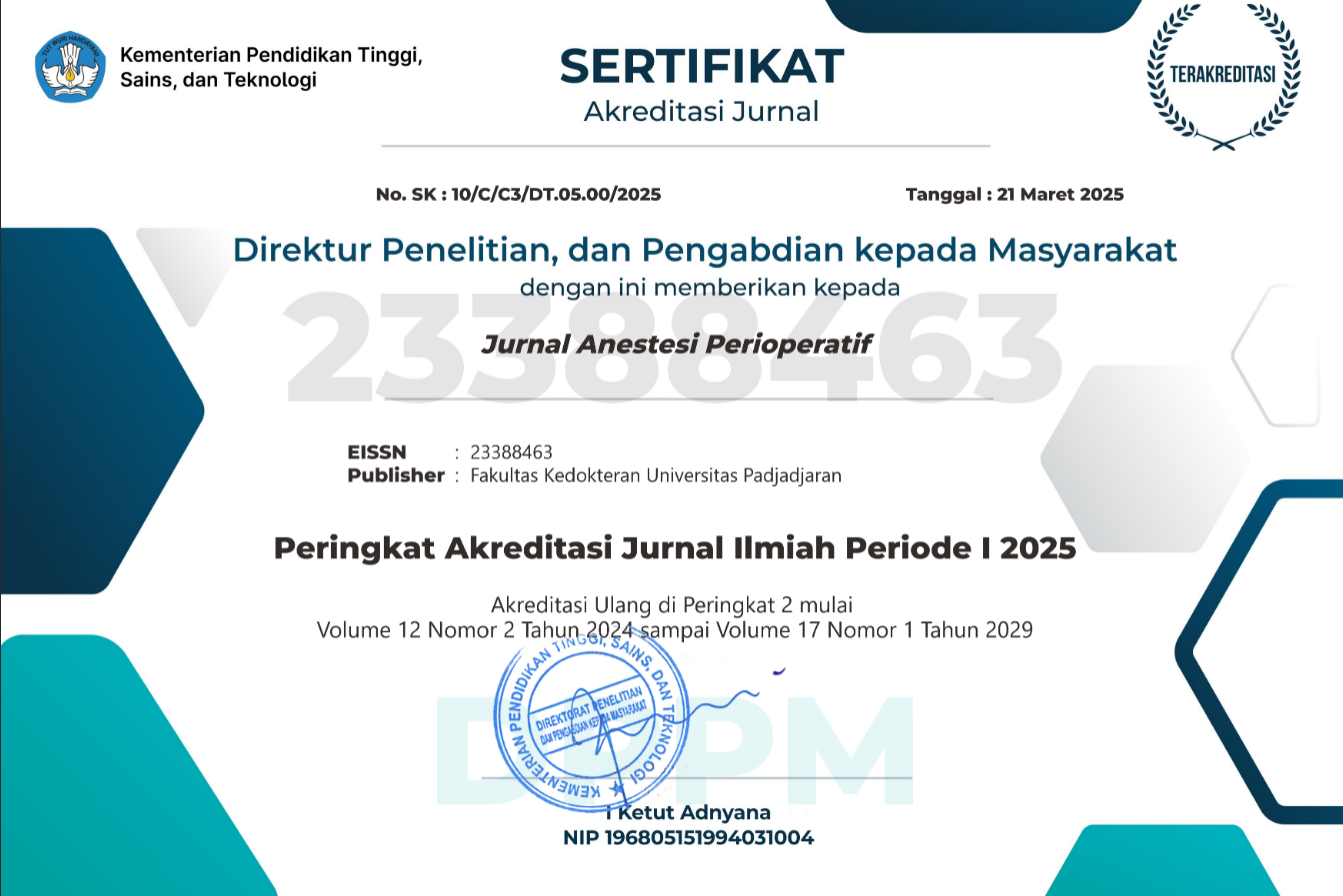Angka Mortalitas pasien Neonatus yang Menjalani Operasi berdasar atas Kenaikan Berat Badan Pascaoperasi yang Dirawat di Neonatal Intensive Care Unit (NICU)
Abstract
Salah satu faktor risiko mortalitas pada neonatus yang menjalani operasi adalah regulasi cairan intraoperatif. Tujuan penelitian ini mengetahui angka mortalitas pada neonatus yang menjalani operasi berdasar atas kenaikan berat badan pascaoperasi yang dirawat di NICU. Metode penelitian adalah deskriptif dengan pendekatan retrospektif. Penelitian ini melibatkan 95 subjek penelitian, yaitu neonatus yang menjalani operasi dan dirawat di NICU RSHS Bandung selama tahun 2010‒2015. Data diambil dari rekam medis, pengambilan data mulai tanggal 1 Februari–29 Maret 2017. Subjek dibagi tiga kelompok, yaitu neonatus yang telah menjalani prosedur operasi yang mengalami kenaikan berat badan pascaoperasi kurang 10% (I), neonatus yang menjalani prosedur operasi yang mengalami kenaikan berat badan 10‒20% (II), dan kelebihan berat badan ≥20% (III). Neonatus pacaoperasi dengan kenaikan berat badan ≤10% sebanyak 46 pasien dan yang meninggal sebanyak 10 pasien pada kenaikan berat badan 10‒20% sebanyak 38 pasien, pasien yang meninggal sebanyak 23 pasien, angka mortalitasnya sebesar 60,5%, sedangkan pada pasien dengan kenaikan berat badan sama dengan atau lebih dari 20% sebanyak 11 pasien atau 11,5% yang meninggal sebanyak 10 pasien, angka mortalitasnya sebesar 90,9%. Simpulan angka mortalitas pasien neonatus yang menjalani operasi di RSHS dan pascaoperasi dirawat di NICU RSHS selama periode 2010–2015 adalah 45,3%.
Kata kunci: Kenaikan berat badan, mortalitas, neonatus
The Mortality Rate in Neonatal Patients which Underwent Surgical Procedures-Defined by the Escalation of Postoperative Weight and Those Who were Admitted in Neonatal Intensive Care Unit (NICU)
One of the risk factors contributed to this number was the inappropriate management of intraoperative fluid resuscitation. The aim of this study is to understand the mortality rate in neonatal patients which underwent surgical procedures–defined by the escalation of postoperative weight and those who were admitted in NICU. The research method used in this study was a retrospective approach presented in a descriptive manner. The study involved 95 research subjects, which were neonatal patients which underwent surgical procedures and admitted in NICU RSHS Bandung from 2010‒2015. Data collection from Februari 1st–March 29th 2017. The research subjects were classified into three groups, neonatal patients which had escalation of weight postoperative less than 10% and underwent surgical procedure (I), neonatal patients which had escalation of weight postoperative ranging from 10‒20% and underwent surgical procedure (II), meanwhile consist of neonatal patients which had escalation of weight postoperative ≥20% and underwent surgical procedure (III). Result of the study showed there were 46 neonatal patients with 10% weight escalation and 10 out of 46 patients were ceased, meanwhile there were 38 neonatal patients with 10‒20% weight escalation and 23 out of 38 were ceased, and there were 11 neonatal patients with ≥20% weight escalation and 10 out of 11 were ceased. The conclusions of this study found a mortality rate of neonatal patients who underwent surgery and postoperative treated in NICU RSHS during the period 2010 to 2015 is 45.3%.
Key words: Weight gain, mortality, neonatal
Keywords
Full Text:
PDFReferences
Morgan GE. Pediatric anestesi. Dalam: Morgan GE, Mikhail MS, Muray MJ, penyunting. Clinical anesthesiology. Edisi ke-5. New York: McGraw Hill; 2012. hlm. 877−905.
Silva JM, Ribas AM, Oliveira RD, Nogueira FA , Vianna FM , Filho MC. The effect of excess fluid balance on the mortality rate of surgical patients: a multicenter prospective study. Crit Care. 2013;17(R288):1−7.
Stewart R, Walsh, Tjun Y, Coveney. Perioperative fluid restriction reduces complications after major gastroentistinal surgery. Spec Reg Gen Surg. 2008;143(4):466−8.
Ketharanatha N, McCulloch M, Wilson C, Rossouw N, Salie S, Ahrens J. Fluid overload in a South African Pediatric Intensive Care Unit. Erasmus University Rotterdam Oktober 2014. J Trop Pediatr. 2014;60(6):428−33.
Lowell JA, Schifferdecker C, Driscoll DF, Benotti PN, Bistrian BR. Postoperative fluid overload: not a benign problem. Crit Care Med. 1990;18(27):728−33.
Sutherland SM, Zappiteli M. Fluid overload and mortality in children receiving continuos renal replacement therapy: the prospective pediatric receiving continuos renal replacement therapy. Am J Kidney Dis. 2010:55(3):316−25.
Lieharrt A, Auoroy Y, Bovet M, Survey of anesthesia related mortality in France. Anesthesiology. 2006;105:1087−97.
Machanda V, Sarin YK, Ramji S. Prognosis factors determining mortality in surgical neonatus. J Neon Surg. 2012;1(1):1−7.
Ilori IU, Ituen AM, Eyo CS. Factors associated with mortality in neonatal surgical emergencies in a developing tertiary hospital in Nigeria. Open J Pediatr. 2013;3:231−5.
Gangopadhyay AN, Upadhyaya VD, Sharma SP. Neonatal surgery: a ten year audit from a University Hospital. Ind J Pediatr. 2008;75(10):1025−30.
Farroow SC, Fowkes FG, Lunn JN, Samuel P. Epidemiology in anaesthesia II: factors mortality in hospital. Br J Anaesth. 1982;52:811−7
Kuremu RT, Kituyi PW, Tenge CN, Kerubo. Neonatal surgical emergencies at Moi Teaching and referral hospital in Eldoret-Kenya. East Centr African J Surg. 2007;12(2):36−9.
Catre D, Lopes MF, Matrigal A, Oliveiros B, Viana JS, Cabrita AS. Early mortality after neonatal surgery: analysis of risk factor in an optimized health care system for the surgery newborn. Rev Bras Epidemiol. 2013;16(4):943−52.
Ayse A, Zappitelli M, Stuart L, Naipaul A, Larry S, Loftis L. Fluid overload is associated with impaired oxygenation and morbidity in critically ill children. Pediatr Crit Care Med. 2012;13(3):233–8.
Rocca GD, Vetrugno L, Tripi G, Deana C, Barbariol F, Pompei L. Liberal or restricted fluid administration: are we ready for a proposal of a restricted intraoperative approach?. BMC Anesthesiol. 2014;14:1−8.
Lee J, Louw ED, Niemi M, Nelson R, Mark RG, Leo A, dkk. Association between fluid balance and survival in critically ill patients. J Intern Med. 2015;277(4):468–77.
Lobo DN, Macafee DA, Allison SP. How perioperatif fluid balance influences postoperative output. Best Pract Resc Clin Anest. 2006;20:439−55.
DOI: https://doi.org/10.15851/jap.v5n2.1112
Article Metrics
Abstract view : 1020 timesPDF - 1540 times
This Journal indexed by

JAP is licensed under a Creative Commons Attribution-NonCommercial 4.0 International License
View My Stats



